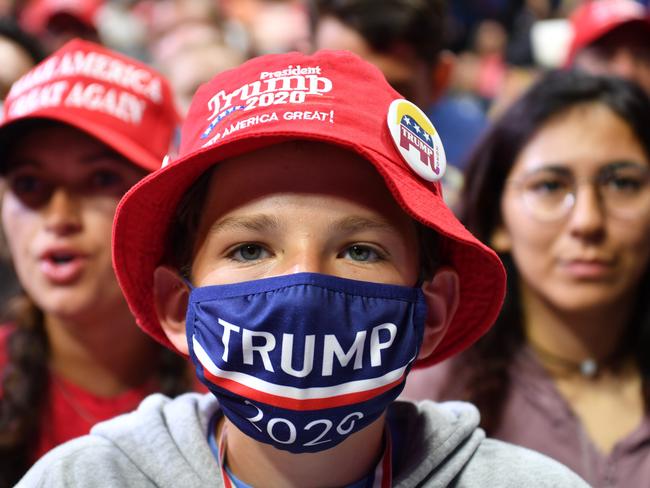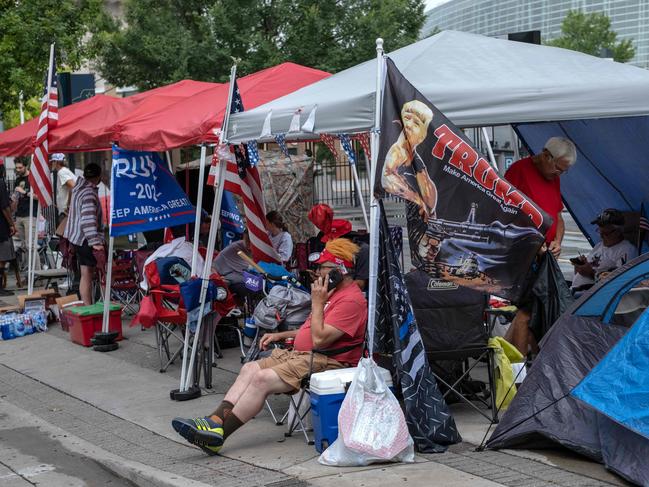Donald Trump’s election rallies: what goes on behind the camera
Donald Trump is currently underwater in several key polls. But what you see on the TV news in Australia does not reflect the reality inside the thunderdome.

Leaders
Don't miss out on the headlines from Leaders. Followed categories will be added to My News.
The first and most surprising thing I found at the Trump rallies I have attended is how happy everyone is.
If you’ve only seen them on the TV news in Australia, the yelling demonstrators outside and table-thumping sound bites from the circus-master president don’t reflect the reality inside the thunderdome.
At my first rally in Orlando last year, there were dozens of children, multi-generation families and groups of teenage friends.
And while the majority of the attendees were white, it wasn’t hard to spot people of colour, including a young, multi-race family who sat in front of me in Florida, joining the chant of “build the wall”.
Amid blowback over his handling of civil unrest and response to the coronavirus, Donald Trump is currently underwater in several key polls, behind his Democratic rival in the six swing states that won him the job and having apparently lost the moderate vote.
A devastating editorial in the conservative-leaning Wall St Journal yesterday warned Trump was facing a “an historic repudiation that would take the Republican Senate down with him”.
“President Trump may soon need a new nickname for “Sleepy Joe” Biden. How does President-elect sound? On present trend that’s exactly what Mr Biden will be,” wrote the paper’s editorial board.


But his supporters, who remain almost 40 per cent of American voters, refuse to hear a bad word about him.
The fans who lined up last week to join the first Trump rally for three months at Tulsa’s BOK Centre were convinced that he will win a second term in November.
And even though there was disappointing turnout – with a crowd of under 7000 a mere fraction of the “million RSVPs” of which his campaign had boasted – there were wide smiles and handshakes once they got past protesters and into the arena.
“These are my people,” explained a grey-ponytailed volunteer, grinning beneath his “Bikers for Trump” headband and handing out masks at one entry point.
“You don’t have to wear the mask,” he advised, pointing 50m down a winding path to where blue-smocked workers were conducting temperature checks of attendees.
“Just keep it on until you get past those ladies.”

Inside the stadium, an all-American playlist was pumped out of loudspeakers in between speeches from Trump surrogates, some of his family members, and Vice President Mike Pence.
At the edge of the premium space in front of the stage, several hefty men were filmed pulling off some awkward dance moves to a Michael Jackson song.
In following days, a video of these guys dancing was widely shared on social media and some of the commentariat scoffingly urged them to “drink some bleach”.
Early last Sunday morning, the line outside the only open food shop in Tulsa airport was a mix of sleepy media and a crew of red-hat wearing Trump supporters.

The President’s boosters gathered around metal tables drinking bad coffee, cheerfully reminiscing about the rally highpoints and Trump’s performance, when they suddenly came to their feet to high-five a new arrival.
“Great job last night!’, they said to 55-year-old Blake Marnell, a broadly smiling salesman from San Diego.
In his brick-orange “build the wall” suit and red Make America Great Again cap, Marnell is a minor celebrity in Trump world, and has even been called onto the stage for a prized presidential handshake.
A lifelong Republican, Marnell didn’t vote in 2016 and wasn’t convinced President Trump would be a good leader until a few weeks into his presidency.
“I wanted President Trump to win, but I did not think that he would be effective,” Marnell explains.
“I thought that he would just not able to govern effectively and that people would have to re-evaluate how they choose their presidential candidates.”
But Marnell said he was impressed at how Trump “started keeping his campaign promises right away”, by pulling out of the Trans-Pacific Partnership trade deal immediately after his January 2017 inauguration, and withdrawing from the Paris Climate Accord.
“He was just doing the things he said he would do, and that made me pay attention,” Marnell says.

Active on social media and a proficient maker of shareable online videos known as memes, Marnell decided after several conservative voices were “de-platformed” by social media companies that he would turn himself into a “human meme”.
“When I saw all these conservative voices being blanked out due to … not abiding by the rules of Twitter, I started thinking, ‘well, if they‘re going to do things like that on the internet, I’m going to start meming in real life’,” he explains.
“I’m going to start going out in public with Trump gear on, because in America there are no terms of service other than the Constitution and the Bill of Rights. I can go into a Starbucks and I can wear my red Trump hat and people can be upset about it and they could be offended by it. But that‘s their choice – there is nothing they can do about it.”
What Marnell discovered is what becomes clear if you go to a Trump rally or spend time outside America’s liberal-voting coastal cities: there is no sense of shame among his supporters.
“All the stories you saw in the media of people wearing Trump hats, you would only see the negative stories, yet you would see the stories of someone who would be assaulted or someone who had a milk shake thrown on them or somebody attacks them,” he says.
“My experience was completely different. I would get people who didn‘t like it. But I would never get anybody who was physical with me. For the most part, the reactions are positive. People were excited to see someone expressing a conservative viewpoint in such a conspicuous manner in public.”
Originally published as Donald Trump’s election rallies: what goes on behind the camera
